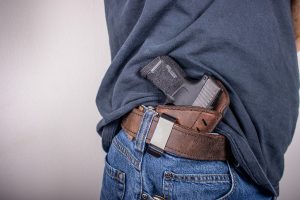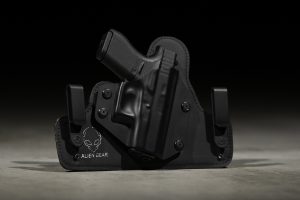Yet to be familar with What is the difference between class 1 and class 2 concealed carry in North Dakota? Well, The primary difference between Class 1 and Class 2 concealed carry permits in North Dakota is that Class 1 permits are for state residents, whereas Class 2 permits are for non-residents, though both require similar training and background checks.
Concealed carry permits in North Dakota are classified into two main categories: Class 1 and Class 2.
Each classification carries distinct requirements, privileges, and implications for firearm owners in the state.
In this comprehensive guide, we delve into the differences between Class 1 and Class 2 concealed carry permits, helping you navigate the nuances and make informed decisions about your rights and responsibilities as a gun owner in North Dakota.
What Is The Difference Between Class 1 And Class 2 Concealed Carry In North Dakota?
Class 1 Concealed Carry Permit
A Class 1 concealed carry permit in North Dakota is designed for residents who meet specific criteria set by state law. To obtain a Class 1 permit, applicants must:
- Be at least 21 years of age.
- Be a resident of North Dakota for at least one year preceding the application, unless exempted by state law.
- Complete a firearms safety and training course approved by the state.
- Pass a background check, which includes criminal history and mental health records.
Once issued, a Class 1 permit allows the holder to carry a concealed firearm statewide, except in restricted areas such as schools, government buildings, and other locations prohibited by law. It grants the holder the legal authority to possess and use a concealed handgun for self-defense purposes.
Class 2 Concealed Carry Permit
On the other hand, a Class 2 concealed carry permit is available to non-residents of North Dakota who wish to carry a concealed firearm within the state. The requirements for obtaining a Class 2 permit include:
- Meeting the minimum age requirement of 21 years.
- Completing a recognized firearms safety and training course.
- Passing a thorough background check similar to that for Class 1 permits.
A Class 2 permit provides non-residents with the ability to carry a concealed handgun in North Dakota, subject to the same restrictions and regulations applicable to Class 1 permit holders. It is crucial for non-residents to familiarize themselves with North Dakota’s specific laws and reciprocity agreements with other states regarding concealed carry.
Key Differences Between Class 1 and Class 2 Permits
The primary differences between Class 1 and Class 2 concealed carry permits in North Dakota can be summarized as follows:
- Residency Requirement: Class 1 permits are exclusively for North Dakota residents, whereas Class 2 permits cater to non-residents.
- Application Process: North Dakota residents must fulfill additional residency-related criteria compared to non-residents applying for a Class 2 permit.
- Legal Validity: Both permits allow holders to carry concealed firearms in North Dakota, with similar restrictions on prohibited areas.
Benefits of Each Permit Class
Benefits of Class 1 Permit
- Allows North Dakota residents to carry a concealed handgun throughout the state.
- Provides legal protection under North Dakota laws regarding self-defense and firearm use.
- Simplifies the process for renewal and updates as required by state regulations.
Benefits of Class 2 Permit
- Enables non-residents to legally carry a concealed firearm while visiting or temporarily staying in North Dakota.
- Recognizes reciprocity with other states, facilitating interstate travel with a concealed handgun.
- Upholds the rights of non-residents under North Dakota law, ensuring compliance with local regulations.
What Is The Difference Between Class 1 And Class 2 Concealed Carry In North Dakota FAQs
1. What are Class 1 and Class 2 concealed carry permits in North Dakota?
Class 1 and Class 2 concealed carry permits in North Dakota are different categories of permits issued to individuals allowing them to legally carry concealed firearms within the state. Class 1 permits are for North Dakota residents, while Class 2 permits are for non-residents.
2. Who qualifies for a Class 1 concealed carry permit in North Dakota?
To qualify for a Class 1 concealed carry permit in North Dakota, you must:
- Be at least 21 years old.
- Be a resident of North Dakota for at least one year, unless exempted by state law.
- Complete an approved firearms safety and training course.
- Pass a background check, which includes criminal history and mental health records.
3. What are the requirements for obtaining a Class 2 concealed carry permit in North Dakota?
The requirements for obtaining a Class 2 concealed carry permit in North Dakota include:
- Being at least 21 years old.
- Completing a recognized firearms safety and training course.
- Passing a background check similar to that for Class 1 permits.
4. Can non-residents of North Dakota apply for a Class 1 concealed carry permit?
No, Class 1 permits are specifically for residents of North Dakota. Non-residents must apply for a Class 2 concealed carry permit to legally carry a concealed firearm in the state.
5. What are the main differences between Class 1 and Class 2 concealed carry permits?
The primary differences include:
- Residency requirement: Class 1 permits are for North Dakota residents, while Class 2 permits are for non-residents.
- Application process: North Dakota residents must meet specific residency-related criteria, whereas non-residents apply under different guidelines.
- Legal validity: Both permits allow concealed carry in North Dakota, but Class 2 permits also recognize reciprocity with other states.
6. Are there different restrictions or privileges associated with Class 1 and Class 2 permits?
Both permit holders are subject to similar restrictions on where concealed firearms can be carried, such as schools and government buildings. However, the process for renewal and updates may differ slightly between the two classes.
7. How long are Class 1 and Class 2 concealed carry permits valid in North Dakota?
Both Class 1 and Class 2 permits are typically valid for a specified period, after which they must be renewed according to North Dakota state law. The renewal process ensures that permit holders remain compliant with current regulations and continue to meet the necessary requirements.
Conclusion
Understanding the differences between Class 1 and Class 2 concealed carry permits in North Dakota is crucial for anyone considering firearm ownership or carrying a concealed handgun within the state.
Whether you are a resident meeting the criteria for a Class 1 permit or a non-resident applying for a Class 2 permit, adhering to the state’s regulations and completing the necessary training are essential steps in obtaining and maintaining your permit.